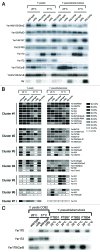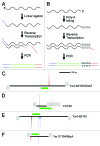Identification and characterization of small RNAs in Yersinia pestis
- PMID: 23324607
- PMCID: PMC3672283
- DOI: 10.4161/rna.23590
Identification and characterization of small RNAs in Yersinia pestis
Abstract
Yersinia pestis, the etiologic agent of plague, is closely related to Yersinia pseudotuberculosis evolutionarily but has a very different mode of infection. The RNA-binding regulatory protein, Hfq, mediates regulation by small RNAs (sRNAs) and is required for virulence of both Y. pestis and Y. pseudotuberculosis. Moreover, Hfq is required for growth of Y. pestis, but not Y. pseudotuberculosis, at 37°C. Together, these observations suggest that sRNAs play important roles in the virulence and survival of Y. pestis, and that regulation by sRNAs may account for some of the differences between Y. pestis and Y. pseudotuberculosis. We have used a deep sequencing approach to identify 31 sRNAs in Y. pestis. The majority of these sRNAs are not conserved outside the Yersiniae. Expression of the sRNAs was confirmed by Northern analysis and we developed deep sequencing approaches to map 5' and 3' ends of many sRNAs simultaneously. Expression of the majority of the sRNAs we identified is dependent upon Hfq. We also observed temperature-dependent effects on the expression of many sRNAs, and differences in expression patterns between Y. pestis and Y. pseudotuberculosis. Thus, our data suggest that regulation by sRNAs plays an important role in the lifestyle switch from flea to mammalian host, and that regulation by sRNAs may contribute to the phenotypic differences between Y. pestis and Y. pseudotuberculosis.
Keywords: Deep-RACE; Hfq; RNA-seq; Y. pseudotuberculosis; Yersinia pestis; plague; small RNA.
Figures


References
-
- Skurnik M, Peippo A, Ervelä E. Characterization of the O-antigen gene clusters of Yersinia pseudotuberculosis and the cryptic O-antigen gene cluster of Yersinia pestis shows that the plague bacillus is most closely related to and has evolved from Y. pseudotuberculosis serotype O:1b. Mol Microbiol. 2000;37:316–30. doi: 10.1046/j.1365-2958.2000.01993.x. - DOI - PubMed
-
- Mayer L, Greenstein AJ. Acute yersinial ileitis: a distinct entity. Am J Gastroenterol. 1976;65:548–51. - PubMed
Publication types
MeSH terms
Substances
Grants and funding
LinkOut - more resources
Full Text Sources
Other Literature Sources
